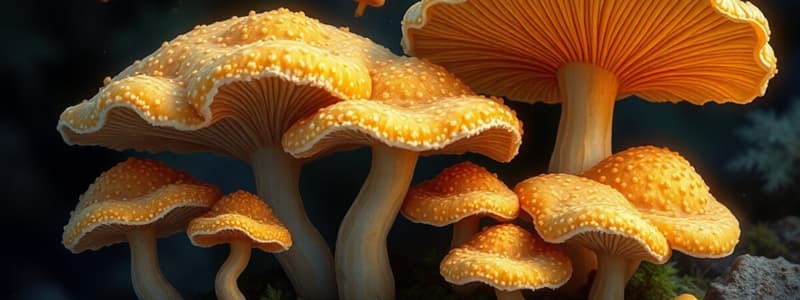Podcast
Questions and Answers
What growth medium is typically used for growing fungi to identify them macroscopic features?
What growth medium is typically used for growing fungi to identify them macroscopic features?
- Potato dextrose agar (correct)
- Mannitol salt agar
- Blood agar
- Nutrient agar
Which method helps determine the phenotype of yeasts using nitrogen or carbon?
Which method helps determine the phenotype of yeasts using nitrogen or carbon?
- Nutrient broth
- Nutrient agar
- Selective agar
- Dye pour-plate auxanogram (correct)
When identifying molds, which characteristic is NOT typically assessed?
When identifying molds, which characteristic is NOT typically assessed?
- Aroma (correct)
- Growth rate
- Colony shape
- Color
What type of agar is primarily mentioned for isolating molds?
What type of agar is primarily mentioned for isolating molds?
What is the purpose of the pH dye indicator in the dye pour-plate auxanogram?
What is the purpose of the pH dye indicator in the dye pour-plate auxanogram?
What is a characteristic of dimorphic fungi?
What is a characteristic of dimorphic fungi?
What color does B. Dermatitidis turn as it ages?
What color does B. Dermatitidis turn as it ages?
What do dermatophytes prefer as a food source?
What do dermatophytes prefer as a food source?
What type of agar do Actinomycetes grow in?
What type of agar do Actinomycetes grow in?
What happens to the pH when dermatophytes utilize protein?
What happens to the pH when dermatophytes utilize protein?
Flashcards
Fungi growth medium
Fungi growth medium
Potato dextrose agar is a common growth medium for fungi used to observe their macroscopic features.
Yeast phenotype method
Yeast phenotype method
Dye pour-plate auxanogram lets us see how yeast grow using nitrogen or carbon.
Mold identification - what's NOT assessed?
Mold identification - what's NOT assessed?
Aroma isn't typically used in identifying molds.
Mold isolation agar
Mold isolation agar
Signup and view all the flashcards
Dye pour-plate pH indicator
Dye pour-plate pH indicator
Signup and view all the flashcards
Dimorphic fungi
Dimorphic fungi
Signup and view all the flashcards
B. Dermatitidis aging color
B. Dermatitidis aging color
Signup and view all the flashcards
Dermatophyte food source
Dermatophyte food source
Signup and view all the flashcards
Actinomycetes growth agar
Actinomycetes growth agar
Signup and view all the flashcards
Dermatophyte pH effect
Dermatophyte pH effect
Signup and view all the flashcards
Study Notes
Identifying Fungi
- Macroscopic methods involve growing fungi on Potato Dextrose Agar (PDA) plates, which support most fungi growth.
- Different agar types can also aid in identifying specific fungi species.
Identifying Yeast
- Yeasts are analyzed by determining their ability to use nitrogen or carbon as their sole food source.
- The Dye Pour-Plate Auxanogram (DPPA) technique involves adding nitrogen and carbon with agar and a pH dye indicator; color change indicates growth.
- Slanted agar tubes provide increased growth area for better observation.
Identifying Mold
- Macroscopic characteristics include color, growth rate, and colony shape.
- Molds are typically cultured on Sabouraud's glucose peptone agar, ensuring consistent growth rates from the same agar supplier.
Identifying Dimorphic Fungi
- Dimorphic fungi exhibit both mold and yeast phases; identification often involves inducing the yeast phase.
- Three main dimorphic fungi:
- Histoplasma capsulatum: White or tan, fuzzy, takes weeks to mature.
- Blastomyces dermatitidis: Starts as white and fuzzy, turns yellow as it ages.
- Coccidioides immitis: Smooth, large tan colonies.
Identifying Dermatophytes
- Dermatophytes grow on Sabouraud's glucose peptone agar with added antifungal and antibacterial agents to limit other growth.
- Prefer protein as a food source, leading to an alkaline pH, which alters the color of the agar.
- Typically appear white, light-yellow, or tan with a cottony or powdery texture.
Identifying Actinomycetes
- Actinomycetes are bacteria resembling fungi, forming filaments and spores.
- They produce leathery or smooth colonies, which can appear white or as small creamy-colored pinpoint colonies.
- Grown in seawater agar for optimal cultivation.
Studying That Suits You
Use AI to generate personalized quizzes and flashcards to suit your learning preferences.




